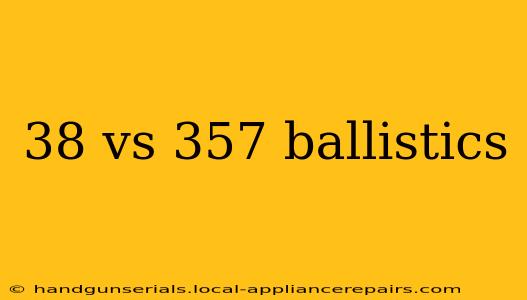Choosing between a .38 Special and a .357 Magnum often comes down to a careful consideration of ballistic performance, intended use, and personal preference. While both cartridges share the same basic cartridge case dimensions, their performance characteristics differ significantly, impacting their suitability for various applications. This deep dive will explore the key ballistic differences between these two popular revolver rounds.
Understanding Ballistic Differences
The primary difference between the .38 Special and the .357 Magnum lies in their powder charge and projectile velocity. The .357 Magnum utilizes a significantly larger powder charge, resulting in considerably higher muzzle velocity and energy. This translates to a flatter trajectory, longer effective range, and greater stopping power.
Muzzle Velocity and Energy:
-
.38 Special: Typically boasts a muzzle velocity ranging from 750 to 950 feet per second (fps), with muzzle energy usually falling between 150 and 250 foot-pounds (ft-lbs). These figures vary widely depending on the bullet weight and the specific firearm used.
-
.357 Magnum: Generally exhibits a muzzle velocity between 1200 and 1500 fps, with muzzle energy often exceeding 500 ft-lbs. Again, this varies based on bullet weight and firearm. The higher velocity leads to a dramatically increased kinetic energy impact on target.
Trajectory and Range:
The higher velocity of the .357 Magnum results in a flatter trajectory. This means the bullet drops less over distance, extending its effective range. The .38 Special, while adequate for close-range self-defense, loses accuracy and effectiveness at longer ranges compared to its more powerful counterpart.
Stopping Power:
The increased velocity and energy of the .357 Magnum contribute to superior stopping power. This doesn't automatically equate to a "one-shot stop" in every scenario, as many factors influence stopping power, including shot placement. However, the Magnum's higher energy transfer is more likely to cause significant tissue damage and incapacitation.
Recoil:
A significant trade-off with the .357 Magnum's power is increased recoil. The heavier recoil can make the Magnum less comfortable to shoot, especially for novice shooters or those with smaller builds. The .38 Special, with its gentler recoil, is generally considered more manageable and easier to control.
Cartridge Compatibility:
A crucial point to note is that a .357 Magnum revolver can fire .38 Special cartridges, but not vice versa. This makes the Magnum a more versatile option, allowing the shooter to choose between the higher power of the Magnum round and the more manageable recoil of the .38 Special.
Choosing the Right Cartridge:
The best choice between the .38 Special and .357 Magnum depends entirely on individual needs and intended use.
Consider the .38 Special if:
- You prioritize manageable recoil and ease of shooting.
- You primarily need a firearm for close-range self-defense.
- You want a less expensive cartridge to practice with.
Consider the .357 Magnum if:
- You need a cartridge with greater stopping power and longer effective range.
- You're hunting small to medium-sized game.
- You're comfortable handling more recoil.
Conclusion:
Understanding the ballistic differences between the .38 Special and .357 Magnum is vital for making an informed decision. While the Magnum offers superior performance, the Special provides a gentler shooting experience. Careful consideration of your specific needs and shooting capabilities is key to choosing the right cartridge for your firearm. Remember always to prioritize safe and responsible firearm handling practices.

